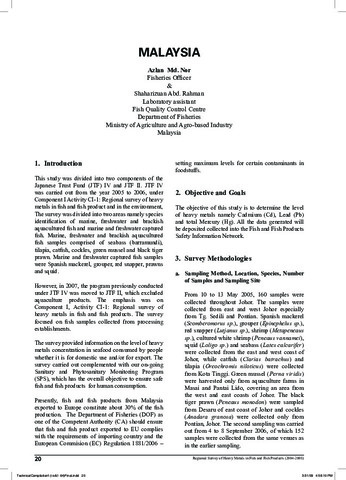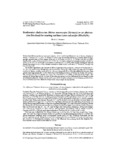Food consumption of seaperch, Lates calcarifer, in captivity.
Share
Abstract
In the Philppines, feeds and constitutes some 70% of the total capital cost in aquacultural, which illustrates the central ipmortance of such inputs and at the same time justifies a major research effort to study the field of nutrition, feeds, and feeding. Given a nutritionally adecquate food, it is necessary to examine whether environmental condition (e.g., water temperature, oxygen , etc.) allow fish to efficiently use the food for growth to ensure a profitable yield. If yioeld is as central to aquaculture as growth is to fish, then the improvement of fish yield in aquaculture should benefit from the fundamental understanding of environmental control of fish growth. In tropical aquaculture where high temperature are the outstanding characteristics, it is worth consideriing whether such temperatures favor efficient fish production. Since temperature increases the rate o metabolic processess in fish, the energetic cost of this elevated metabolic activity may be considered in competition with growth for a share of the energy derived from the food (Brett, 1979). These interacting factors of food (intake and ration) and temperature and their effects on fish growth should be thoroughly studied if an economicaly vaible management is desired.
The present research project focussed on research (Lates calcarofer) aquaculture by using the bio-energetic concept following the models of weel studied species such as perch, Perca fluviatilis (Solomon & Brafield, 1972); sockeye salmon, Oncorhynchus nerka (Brett, 1979); brown trout, salmo trutta (Elliott, 1972; 1975a; 1975b; 1976; 1982), and the African catfish, clarias gariepinus (Hogendoorn, 1983; Machiels & Henken, 1986). This, being a long term goal connat be attained before basic variables will have been studied. The immediate aims of this research project era, therefore, (1) examination of feeding rates and food consumption of the seaperch in relation to body size and temperature, and (2) determination of growth rate in relation to temperature and ration size.
This study will be conducted over a 3-years period. Firstly preliminary trials on feeding rates and food consumption by individual seaperch will be carried out to determine minimumand maximum rations. Subsequently experiments studying the relation between temperature, ration (starvation, maximum, minimum) and growth will be conducted. Variables and parameters to be investigated durig the experiment will concentrate on body size, body composition, composition of growth increment,tempereture and metabolism (oxygen consumption).
Subject
Taxonomic term
Collections
Related items
Showing items related by title, author, creator and subject.
-
Regional survey of heavy metals in fish and fish products: Malaysia
Nor, Azlan Md. (Marine Fisheries Research Department, Southeast Asian Fisheries Development Center, 2008)The paper presents the results of the survey that was conducted to determine the level of heavy metals namely cadmium, lead, and total mercury among the marine, freshwater and brackishwater (aquacultured) fishes in Malaysia. ... -
Regional survey of heavy metals in fish and fish products: Myanmar
Winn, U Than (Marine Fisheries Research Department, Southeast Asian Fisheries Development Center, 2008)The paper presents the results of the survey that aimed to determine the level of heavy metals namely cadmium, lead, and total mercury among fish and fish products in Myanmar. The samples that were analysed include black ... -
Freshwater cladoceran Moina macrocopa (Strauss) as an alternative live food for rearing sea bass Lates calcarifer (Bloch) fry
Fermin, Armando C. (Blackwell Publishing, 1991)Fifteen day old sea bass larvae were acclimated to 10‰ S and fed ad libitum levels of Moina, Artemia or Moina + Artemia (at 1:1 ratio). Fish kept at 32 ‰ S and fed Artemia served as a control. After 20 days, specific growth ...






